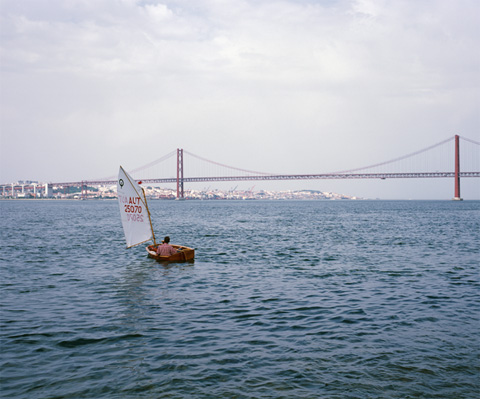Arquivo
2011
Hans Schabus
O espaço do conflito
The Space of Conflict
O espaço do conflito
The Space of Conflict
Curadoria: Pablo Fanego
EXPOSIÇÃO
DE 2 DE JULHO
A 18 DE SETEMBRO
DE 2 DE JULHO
A 18 DE SETEMBRO
Galeria 2
2 Euros
2 Euros
Visita guiada
por Miguel Wandschneider
Sábado, 17 Setembro, 17h
por Miguel Wandschneider
Sábado, 17 Setembro, 17h

Rio Tejo, Lisboa, 26 Junho 2011, 2011
Hans Schabus (Watschig, Áustria, 1970) adquiriu notoriedade no mundo da arte devido, sobretudo, a uma série de projectos específicos realizados em lugares muito diversos (por exemplo, a Secession em Viena, a Kunsthaus de Bregenz, o pavilhão austríaco da Bienal de Veneza, ou o Site Santa Fe). Caracterizados por uma aproximação performativa aos respectivos contextos, esses projectos integravam múltiplos elementos vinculados à própria arquitectura e ao seu enquadramento.
Contudo, se existe um lugar para o qual, em última instância, os seus trabalhos remetem, esse lugar é o espaço do seu atelier, o âmbito físico e mental onde se desenrola o verdadeiro conflito entre o real e o possível, entre o contingente e o fictício. O atelier é, para Schabus, simultaneamente realidade e representação; é o lugar onde passa o seu tempo e onde a realidade é processada como material, e é a metáfora da sua concepção da prática artística e da sua posição no mundo.
O espaço do conflito pretende examinar as múltiplas sinuosidades que caracterizam a busca pessoal de Schabus e o conduzem do atelier à situação, e desta de novo ao atelier. Um duplo movimento em que as estratégias de distanciamento e ficcionalidade – com referências nem sempre explícitas que vão de Brancusi a Bas Jan Ader, de H. David Thoreau à figura country do “andarilho” – são pelo menos tão importantes quanto os dados que nos aproximam daquilo a que chamamos realidade.
Contudo, se existe um lugar para o qual, em última instância, os seus trabalhos remetem, esse lugar é o espaço do seu atelier, o âmbito físico e mental onde se desenrola o verdadeiro conflito entre o real e o possível, entre o contingente e o fictício. O atelier é, para Schabus, simultaneamente realidade e representação; é o lugar onde passa o seu tempo e onde a realidade é processada como material, e é a metáfora da sua concepção da prática artística e da sua posição no mundo.
O espaço do conflito pretende examinar as múltiplas sinuosidades que caracterizam a busca pessoal de Schabus e o conduzem do atelier à situação, e desta de novo ao atelier. Um duplo movimento em que as estratégias de distanciamento e ficcionalidade – com referências nem sempre explícitas que vão de Brancusi a Bas Jan Ader, de H. David Thoreau à figura country do “andarilho” – são pelo menos tão importantes quanto os dados que nos aproximam daquilo a que chamamos realidade.
Hans Schabus (Watschig, Austria, 1970) has acquired great notoriety in the art world due, above all, to a series of specific projects undertaken in very different places and characterised by a performative approach to these contrasting contexts, incorporating multiple elements that were associated with the architecture itself and with its surroundings.
However, if there is a place to which the works of Schabus ultimately refer, it is the space of his studio, the physical and mental space where the true conflict between the real and the possible, between the contingent and the fictitious, unfolds. For Schabus, the studio is simultaneously reality and representation; it is the place where he spends his time and where reality is processed as material, and it is the metaphor for his conception of the artistic practice and of his position in the world.
The Space of Conflict seeks to examine the multiple unevennesses that characterise Schabus’ personal search and lead him from the studio to the situation, and then back to the studio again. A double movement in which the strategies of distancing and fictionality – with references that are not always explicit and range from Brancusi to Bas Jan Ader, from H. David Thoreau to the country figure of the “ramblin’ man ” – are at least as important as the data that bring us closer to what we call reality.
However, if there is a place to which the works of Schabus ultimately refer, it is the space of his studio, the physical and mental space where the true conflict between the real and the possible, between the contingent and the fictitious, unfolds. For Schabus, the studio is simultaneously reality and representation; it is the place where he spends his time and where reality is processed as material, and it is the metaphor for his conception of the artistic practice and of his position in the world.
The Space of Conflict seeks to examine the multiple unevennesses that characterise Schabus’ personal search and lead him from the studio to the situation, and then back to the studio again. A double movement in which the strategies of distancing and fictionality – with references that are not always explicit and range from Brancusi to Bas Jan Ader, from H. David Thoreau to the country figure of the “ramblin’ man ” – are at least as important as the data that bring us closer to what we call reality.
